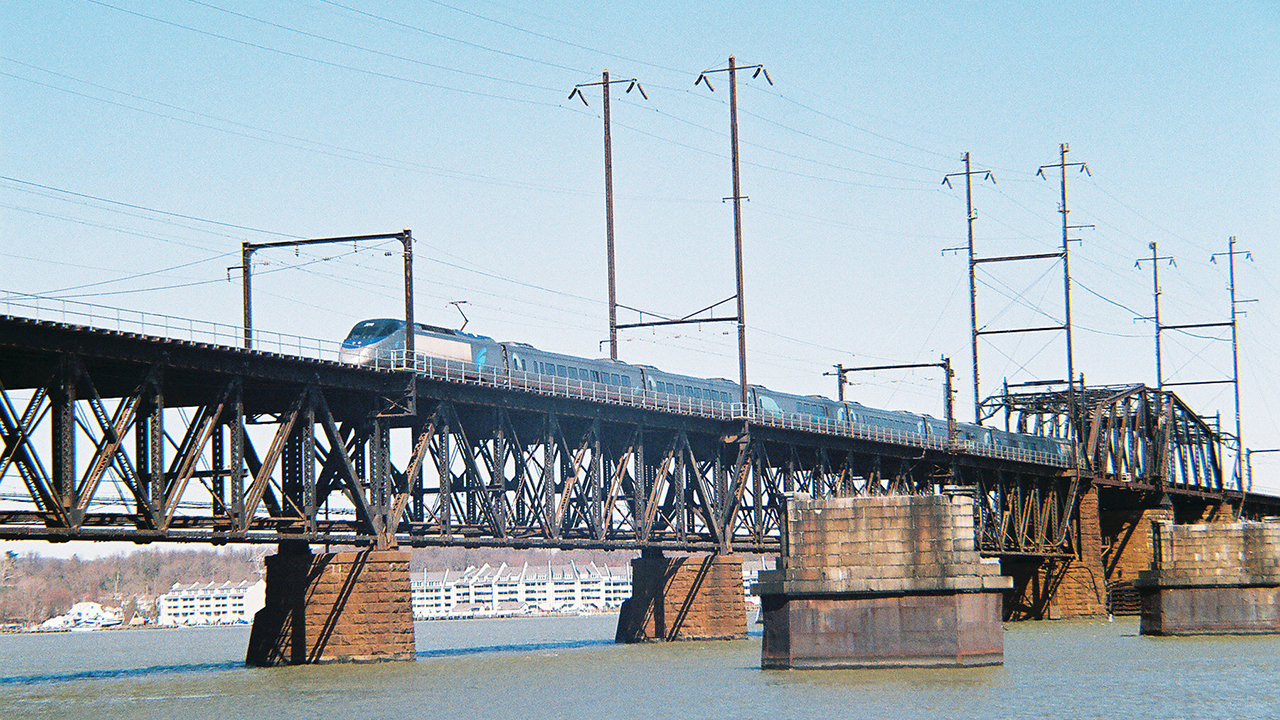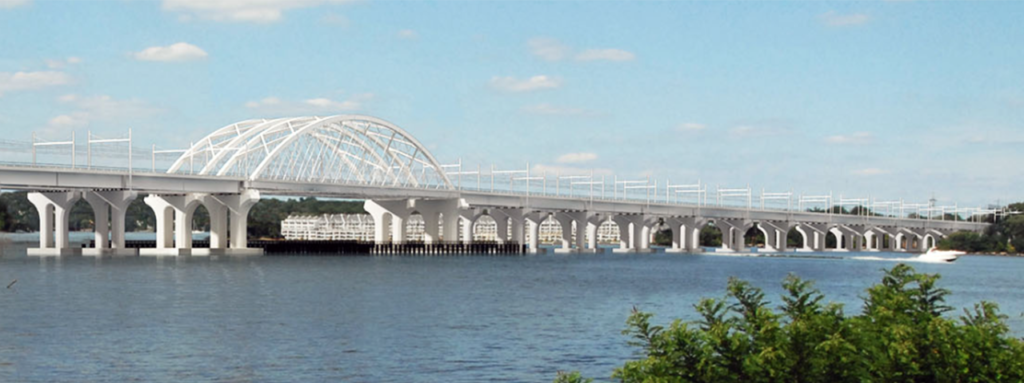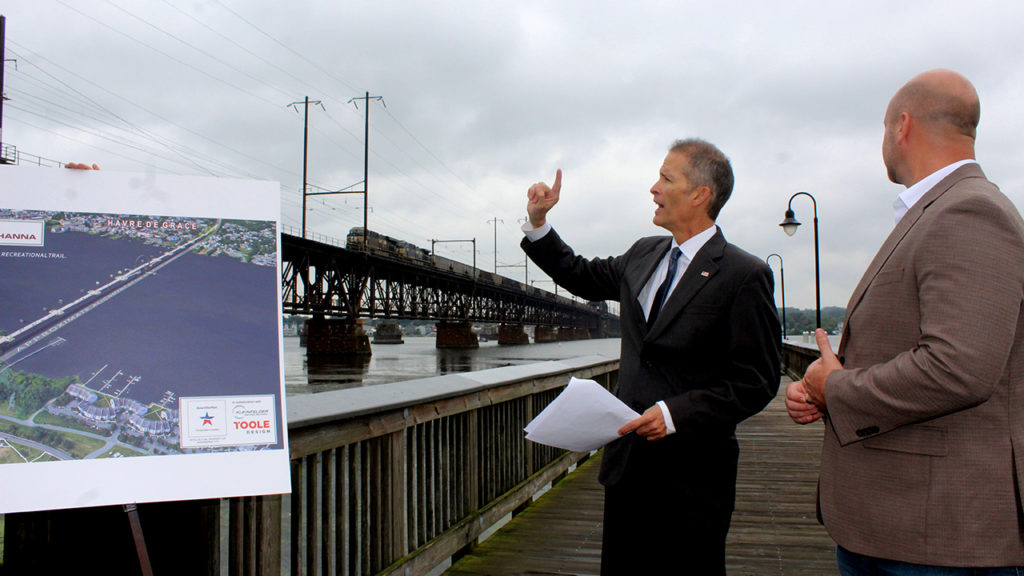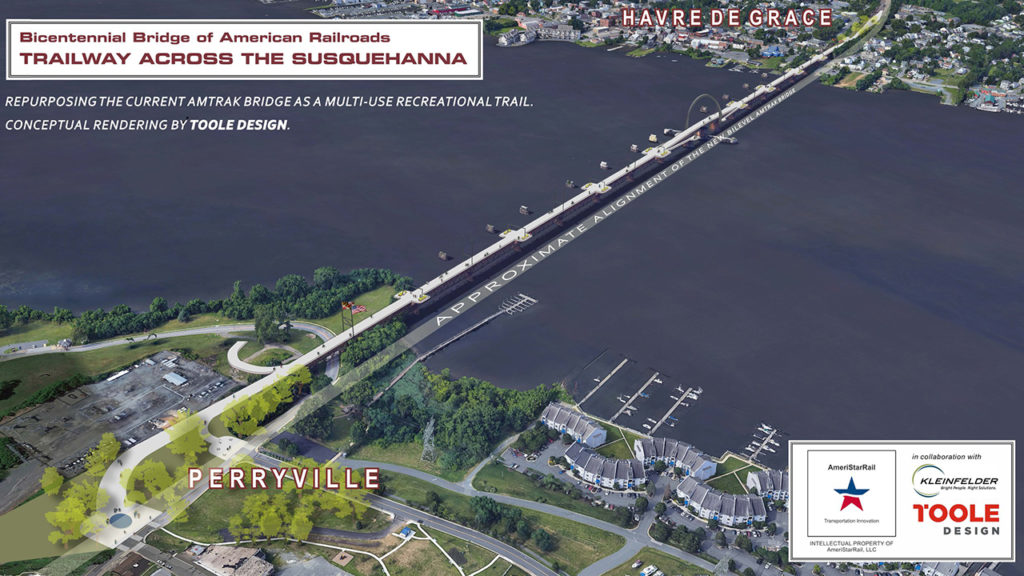
Troubled NEC Bridge Over Maryland Waters
Written by David Peter Alan, Contributing Editor
Southbound Acela Express crossing the Susquehanna River Bridge, at Havre de Grace, Md. James G. Howes/Wikimedia Commons
Amtrak is working on a plan to replace the 117-year-old Howe deck truss bridge over the Susquehanna River between Perryville and Havre-de-Grace, Maryland, railroad west from Delaware and on the way to Baltimore along the Northeast Corridor (NEC). Perryville is located in Cecil County, which borders Newark, Delaware, and currently serves as the northeastern limit of the MARC Penn Line from Washington, D.C. through Baltimore. Amtrak trains do not stop there. No trains serve Havre-de-Grace, which is in Harford County, the county that contains Aberdeen, which has limited Amtrak service. Now there is also a competing proposal. It was recently unveiled by Scott R. Spencer, Chief Operating Officer of AmeriStarRail, which has also proposed a new operating plan for the NEC.
Amtrak’s Fact Sheet for the project includes a history of the bridge that is currently in service that says: “The existing Susquehanna River Rail Bridge was constructed in 1906 by the Pennsylvania Railroad. The bridge is eligible for listing on the State and National Registers of Historic Places. The multi-span truss bridge was built to replace an original 1860s parallel structure to the south. The piers of the original 1860s bridge can still be seen above the water line in the Susquehanna River. Electrified rail service on the 4,154-foot-long bridge began in the 1930s when an overhead catenary system was installed on the bridge.”

Amtrak’s plan includes four tracks, outlined as Alternative 9A of the project study: a new two-track, 90-mph bridge to the west of the current bridge alignment, and demolishment of the existing span, replacing it with a two-track, 160-mph bridge. Study documents and other materials can be found on the Amtrak website in a section about the project. Spencer’s proposal would build a different bridge, while re-purposing the existing one, instead of demolishing it, and that proposal is gaining traction among local officials.
Spencer unveiled the AmeriStarRail plan at an event in Perryville, near the existing elevated railroad structure, on Sept. 26. He is a long-time railroader and currently Chief Operating Officer at AmeriStarRail. Project details, including the full proposal, can be found on the company’s website. According to the site: “Unlike Amtrak’s plan to replace its current bridge, built in 1906, with twin bridges by the Year 2036, AmeriStarRail, in collaboration with Kleinfelder and Toole Design, propose that Amtrak and Maryland DOT finance and build just one bi-level bridge to be completed by 2030 without demolishing the current bridge. This would allow the existing Amtrak bridge to be converted into the Trailway Across the Susquehanna.” The Kleinfelder firm works in the field of railroad design, while Toole Design works in the field of city and town planning.

AmeriStarRail claimed that its plan would deliver other benefits, too: “Unlike Amtrak’s current Susquehanna River Bridge replacement plans, AmeriStarRail’s bi-level bridge solution will eliminate direct operating conflicts between Amtrak trains, MARC commuter trains and Norfolk Southern freight trains at Perryville, which is the busiest freight train junction on Amtrak’s Boston-Washington Northeast Corridor. This will allow Amtrak trains to operate up to 200 mph between Wilmington and Baltimore. Amtrak’s new Acela trains are capable of operating at a top speed of 220 mph.”
Rather than demolishing the existing bridge, Spencer would keep it in place as a walking and bike trail, his version of the “trail with rail” concept, since the double-deck railroad bridge would be adjacent to it. He also called for the original piers from the 1866 bridge on the Philadelphia, Wilmington & Baltimore (PW&B), which originally built the line, to remain in place as historic artifacts in the river. The AmeriStarRail web site touted the benefits of keeping the existing bridge as a trail: “The trailway bridge will close a major missing link in the East Coast Greenway from Maine to Florida for bicyclists and hikers and create a new recreational attraction for Maryland residents and tourists.” Spencer also said that the trailway could be in service by 2032 or 33. Another component of his proposal would be adding a stop a Havre-de-Grace, which is located between Perryville and Aberdeen.

Spencer appealed to history throughout his presentation, even in the name for the proposal: the Bicentennial Bridge of American Railroads and the Trailway Across the Susquehanna. While Spencer concentrated on the technical and transportation aspects of the proposal during his presentation, he also invoked history, as American railroading is about to begin its third century. He told Railway Age that he believes the project can be completed in time to celebrate the bicentennial of the start of service on the Baltimore & Ohio Railroad (B&O) in 1830. He called the piers form the 1866 bridge “monuments to freedom,” because many formerly enslaved people who were freed at the end of the Civil War rode over it, on their way north as they sought opportunities to exercise their new freedom.
Amtrak is skeptical about the proposal. As Jane Bellmyer reported in a comprehensive story for the Cecil Whig (the paper was founded in 1841, when the Whig Party was the political opponent to the Democrats, before the Republicans took over that role) on Sept. 29, Amtrak listed a nuseveralcerns about it. Amtrak spokesperson Beth K. Toll told me: “As discussed in the Susquehanna River Bridge project description and the website for the environmental review of the project, the FRA/MDOT-led environmental review for replacement of the 1906 Susquehanna River Bridge began in 2013 and took more than four years. This process involved extensive stakeholder outreach and consideration of 25 different alternatives (including those proposed by the commentors) before the current plan to replace the bridge was selected. Final design of the replacement bridge, funded in part by a $20 million federal grant secured with the support of Maryland’s Congressional delegation, is underway. Amtrak is also currently seeking a Federal State Partnership for a State of Good Repair Grant from the FRA.”
Spencer does not seem fazed by Amtrak’s objections. The AmeriStarRail web site defended the plan as being superior to Amtrak’s from an operating standpoint: “Unlike Amtrak’s current Susquehanna River Bridge replacement plans, AmeriStarRail’s bi-level bridge solution will eliminate direct operating conflicts between Amtrak trains, MARC commuter trains and Norfolk Southern freight trains at Perryville which is the busiest freight train junction on Amtrak’s Boston-Washington Northeast Corridor.” Spencer also said on the website: “Amtrak is the safest, most environmentally sustainable way to travel. Unfortunately Amtrak has just a single digit market share for all Northeast Corridor trips. More than 85% choose to drive or ride buses on I-95 [according to the Federal Highway Administration]. Eliminating the wear and tear of sharing high-speed tracks with slow, heavy freight trains is essential for operating smooth, safe and reliable Amtrak high-speed service at commercially competitive speeds up to 200 mph.” He also told this writer: “Our proposal will benefit Amtrak for 200 years, so there’s no such thing as ‘too late.’ Amtrak’s proposal still allows conflicts between high-speed rail and freight. Ours would separate them.”
Local officials in Perryville, including Town Administrator George Patchell, expressed support for the new proposal. Mayor Matt Roath was enthusiastic about it. He told me that it brings “benefits to the community not recognized by Amtrak” He criticized Amtrak for “imposing” its plan on his community, and called for “very respectful and reasonable conversation” about the benefits of the AmeriStarRail plan. He added that it would be beneficial for the people of Perryville and Havre-de-Grace, and that he can get the support of the people of the region.
Roath also said that the project would “promote the town of Perryville” and told Railway Age: “We knew conceptually that this project had to be done. Scott has a better concept for the town and for the country for 100 years. His proposal also solves problems of shipping congestion in Perryville.”
Newark, Del. and Perryville are endpoints of a gap in local passenger train service between New York and Washington, D.C. Both Spencer and Roath say that the new plan would facilitate closing that gap by making it easier for MARC to run trains north of Perryville to Newark or Wilmington, Delaware, where they would connect with SEPTA trains to Philadelphia and beyond.
In her report in the Whig, Bellmyer included a photo of Spencer explaining his proposal to Mayor Roath as a Norfolk Southern freight train slowly went by on the line that the freights share with MARC and Amtrak trains. The caption contained the words “as if on cue” along with the description of the content of the image. The engineer on that train blew his horn to salute the assemblage as the train crossed the river. It is tempting to think that the freight going by when it did has a deeper meaning than merely making the content of Bellmyer’s shot more interesting. If nothing else, it demonstrates that trains traveling at vastly different speeds must share the same tracks. Amtrak and AmeriStarRail have differing views of which plan would serve the various stakeholders, including the riding public, best.
The issue of whether the plan that Spencer recommends can stay in the running, despite its late start, is now up to politicians in the Old Line State. The plan has an enthusiastic mayor supporting it, which is a necessary first step, but it’s only a start. Can Roath and his colleagues in local politics generate enough momentum for the proposal to get the support of Annapolis, including the legislature? Can they get the support of Gov. Wes Moore and the Maryland Department of Transportation (MDOT), which would bring Amtrak to the bargaining table, especially before Amtrak’s proverbial train leaves the station?
Those are the big questions as the campaign begins. Spencer sent the Proposal on the AmeriStarRail web site to the governor, along with a letter of transmittal (at 1-2). Moore is a Democrat from Baltimore who has promised support for passenger rail and rail transit. He has already restored the process for considering the Red Line, a proposed light rail line in Baltimore that his predecessor, Larry Hogan, had halted. We contacted the governor’s office and MDOT for comment, but neither responded. That, in itself, might not be significant, since the campaign for Spencer’s proposal is just beginning.
This situation brings back memories to this writer of the struggle over the former Access to the Region’s Core (ARC) Project in New Jersey and New York City which, as late as 2010, was considered “shovel ready” and unstoppable. It included a deep-cavern terminal and other features that some local rider-advocates (including me) believed were undesirable and overpriced. Political experts argued that “You’ll need a governor to stop this.” In October 2010, New Jersey Gov. Chris Christie did just that. The current Gateway Program, which was proposed four months later and remains under discussion although some construction has already started, is the successor to the now-defunct ARC Project.
Can history from 13 years ago in New Jersey repeat itself in Maryland? Making substantial changes to a project that has proceeded as far as Amtrak’s proposal is always a long shot, but it has happened before. Spencer, Mayor Roath and their supporters are hopeful that they can make it happen again.

David Peter Alan is one of America’s most experienced transit users and advocates, having ridden every rail transit line in the U.S., and most Canadian systems. He has also ridden the entire Amtrak and VIA Rail network. His advocacy on the national scene focuses on the Rail Users’ Network (RUN), where he has been a Board member since 2005. Locally in New Jersey, he served as Chair of the Lackawanna Coalition for 21 years, and remains a member. He is also Chair of NJ Transit’s Senior Citizens and Disabled Residents Transportation Advisory Committee (SCDRTAC). When not writing or traveling, he practices law in the fields of Intellectual Property (Patents, Trademarks and Copyright) and business law. Opinions expressed here are his own.



